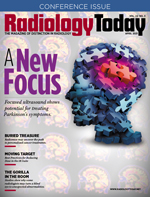 Editor’s Note: Steps in the Right Direction
Editor’s Note: Steps in the Right Direction
By David Yeager
Radiology Today
Vol. 22 No. 3 P. 5
One of the most interesting things about the medical imaging field is that it’s constantly evolving. There never seems to be a shortage of interesting ideas to take established technologies in new directions. Some of the articles in this issue deal with methods of deploying existing technologies in novel ways. Others explore new thinking about existing problem areas. In either case, progress is marching forward. To find out where that progress may be heading, read on.
This month’s cover feature by Kathy Hardy examines a potential new treatment for Parkinson’s disease using focused ultrasound. To date, the predominant treatment for Parkinson’s is medication. Deep brain stimulation is sometimes used, but it is an invasive procedure. A recent clinical trial used focused ultrasound with MR guidance to ablate a small area of the brain involved with movement disorders. Although the procedure is still in its early days, the researchers who conducted the trial are excited about its potential as a less invasive treatment.
Another interesting new technology is radiomics. Aine Cryts reports on the use of radiomics to predict cancer treatment response. The technology is still in the research phase, but researchers believe radiomics will eventually be used to inform treatment plans. The hope is that it may one day be used to personalize treatment based on a patient’s radiomic profile.
There are also advances in dose reduction technology. Keith Loria has a rundown of the latest trends. In addition to updates in equipment design, new protocols are helping clinicians maintain image quality with less dose. Increasing automation and new software are also helping to reduce dose. For more on what’s new in dose reduction, coverage begins on page 18.
Finally, Beth W. Orenstein takes a closer look at a mental process that affects everyone to some degree: inattentional blindness. In this case, it relates to radiologists missing obvious features on medical images, often because they’re looking for something else. According to the experts that Orenstein interviews, the rate of inattentional misses is low, 3% to 4%, but the trend is surprisingly durable over time. There are many hypotheses about how to lower the miss rate further, but, at this time, researchers are still searching for answers.
Enjoy the issue, and stay safe.

